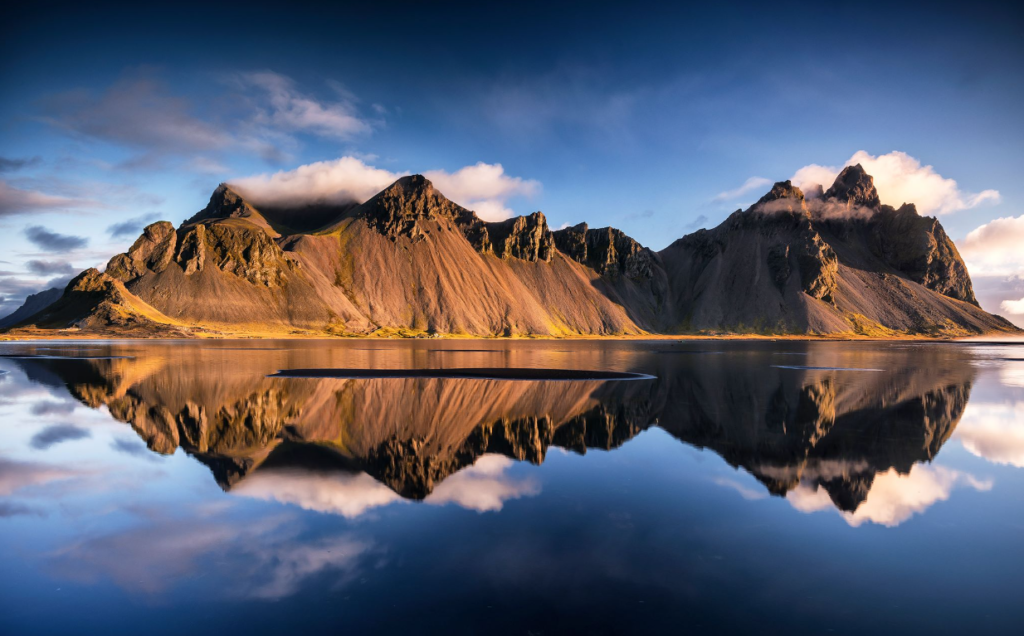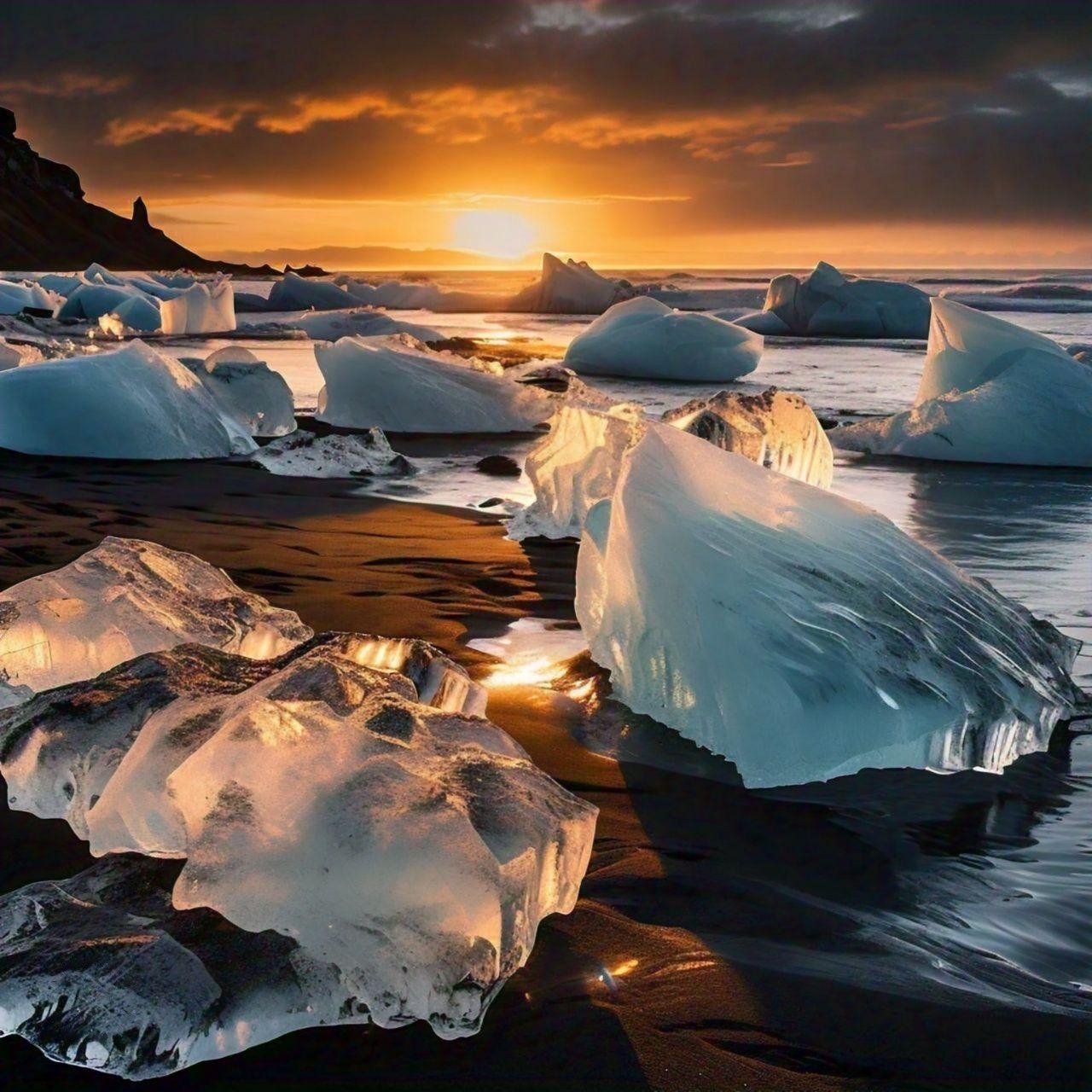Vestrahorn, Iceland one of the most iconic and photogenic locations, is a dramatic mountain range that rises sharply from the sea, earning the nickname “Batman Mountain” due to its jagged peaks and eerie silhouette. Nestled on the southeastern coast of Iceland, near the town of Höfn, this hidden gem is a must-visit for adventure seekers, photographers, and nature lovers alike. As a tour guide, I’ve had the privilege of leading countless visitors to Vestrahorn and have learned some key tips, tricks, and hacks to make your visit unforgettable.
What Makes Vestrahorn Special?
Vestrahorn stands out in Iceland for its striking beauty. Unlike many of the more famous tourist spots, it offers a more secluded experience. The mountain range towers over a sweeping black sand beach, with the wild North Atlantic waves crashing against the shore. What truly makes this place unique is the contrast of its rocky peaks with the soft, undulating dunes of volcanic sand below.
Photographers love it here for its reflections, particularly in the calm pools of water left by the tide. The golden hour here is breathtaking, with the peaks glowing orange against the cool blues of the sky and sea. Whether you’re here to snap the perfect shot, or just want to soak in the natural beauty, Vestrahorn will leave a lasting impression.
How to Get There
Vestrahorn is located around 10 kilometers from Höfn, and the best way to reach it is by car. If you’re traveling from Reykjavik, it’s about a six-hour drive, but the scenic route through South Iceland’s majestic landscapes is worth every minute.
If you’re part of a guided tour, expect to spend about half a day at Vestrahorn. I always recommend making it a full-day trip if you can, as the area is rich with other hidden gems. The closest airport is Egilsstaðir Airport, but most visitors prefer to fly into Reykjavik and make the road trip.
Essential Gear for Your Adventure
Visiting Vestrahorn requires some preparation, especially if you want to fully capture the experience or brave the unpredictable Icelandic weather. Here’s a guide to the essential gear you’ll need:
- Camera and Tripod: Whether you’re a professional photographer or just an Instagram enthusiast, don’t forget your camera! The reflections in the black sand, the towering peaks, and the ever-changing light conditions make for dream shots. A tripod is essential for long exposures, especially if you’re planning to capture the Northern Lights during winter.
- Wide-angle Lens: To fully capture the vastness of Vestrahorn and its surroundings, a wide-angle lens is a must. This allows you to include both the beach and the mountains in your frame.
- Waterproof Boots: The black sand beach often holds pools of water, and the waves can come up unexpectedly. Waterproof boots will keep your feet dry and allow you to explore the dunes without worry.
- Layers and Windproof Jacket: Iceland’s weather is notorious for changing on a dime. Even in summer, the wind here can be quite strong. Dressing in layers, including a windproof jacket, will ensure you stay comfortable throughout the day.
- ND Filters: If you’re into long-exposure photography, don’t forget your neutral density (ND) filters. These will help you control the light and achieve that silky smooth water effect in your shots.
- Snacks and Water: While the area around Vestrahorn is remote, it’s important to stay hydrated and energized. Pack some snacks and water for the journey.

Best Time to Visit
Iceland’s weather can be unpredictable, but each season offers something unique. Here’s my breakdown of the best times to visit:
- Winter (November to March): If you want a chance to see the Northern Lights over Vestrahorn, winter is your best bet. The black sand beaches covered in frost create a surreal contrast with the snowy peaks. However, the days are shorter, and conditions can be harsh, so be prepared for cold temperatures and wind.
- Spring (April to June): The snow begins to melt, and the landscape transforms into vibrant greens. It’s a quieter time to visit, with fewer tourists, and the long daylight hours give you plenty of time to explore.
- Summer (July to August): The Midnight Sun illuminates Vestrahorn in a golden glow, and the wildflowers bloom in the surrounding fields. Summer is perfect for those who want to hike and explore the area without the risk of snow, but expect more tourists.
- Autumn (September to October): Autumn brings beautiful fall colors to the area and fewer visitors. It’s a great time for photography as the weather becomes more unpredictable, creating dramatic skies.
Top Hacks for Visiting Vestrahorn
Here are a few tour guide-approved hacks to ensure you make the most of your trip to Vestrahorn:
- Arrive Early or Stay Late: If you want to avoid the crowds and get the best light for photography, I recommend arriving early in the morning or staying late into the evening. The golden hour just after sunrise and just before sunset offers stunning lighting conditions for photographers.
- Pay the Small Entrance Fee: Vestrahorn is located on private land, so there’s a small entrance fee to access the beach and the Viking Village set (an old movie set built for a film that was never finished). You can pay this fee at the Viking Café nearby. It’s worth it, as the money helps maintain the area.
- Don’t Miss the Viking Village: While Vestrahorn is the main attraction, the nearby Viking Village set adds an extra layer of adventure. It’s a replica of an old Viking settlement and provides a fun backdrop for photos.
- Check the Tide Times: The reflections on the beach are best during low tide when the wet sand creates a mirror-like surface. Make sure to check the tide times before you go.
- Respect the Fragile Environment: Vestrahorn is a sensitive natural area, and the dunes are easily damaged. Stick to the designated paths to avoid harming the fragile ecosystem.
Food and Drink Spots Nearby
After a day of exploring Vestrahorn, you’ll likely be hungry! While the area around Vestrahorn is remote, you can find some great food and drink options in nearby Höfn. Here are a few of my favorites:
- Pakkhús Restaurant: If you’re craving fresh seafood, Pakkhús in Höfn is the place to go. Höfn is known for its lobster, and Pakkhús serves up some of the best in the region. The restaurant is located right by the harbor, offering stunning views as you dine.
- Otto Matur & Drykkur: This cozy spot is perfect for traditional Icelandic dishes with a modern twist. They serve hearty meals made from local ingredients, including lamb and fish dishes.
- Kaffi Hornið: For a more casual dining experience, Kaffi Hornið offers everything from burgers to fish and chips. It’s a great place to relax after a day of adventure, and their homemade desserts are a must-try.
- Viking Café: If you want something quick before or after your visit, the Viking Café, located near the parking area, serves simple yet satisfying meals. It’s also where you’ll pay the entrance fee for Vestrahorn, so it’s a convenient stop.
Final Thoughts: Why You Shouldn’t Miss Vestrahorn
Vestrahorn, Iceland, is one of those places that lingers in your memory long after you’ve left. Whether it’s the towering peaks, the eerie reflections in the black sand, or the solitude of standing on that windswept beach, this place offers a unique blend of natural beauty and serenity.
As a tour guide, I’ve seen visitors from all walks of life stand in awe of this dramatic landscape. For photographers, it’s a paradise of textures and contrasts. It offers an exhilarating experience of Iceland’s raw, untamed wilderness for hikers. It’s a place to disconnect from the hustle and bustle of life and reconnect with the beauty of the earth.
So pack your gear, check the weather, and make your way to Vestrahorn, Iceland. It’s one of the true hidden gems, and I promise, it will be a highlight of your Icelandic adventure.


